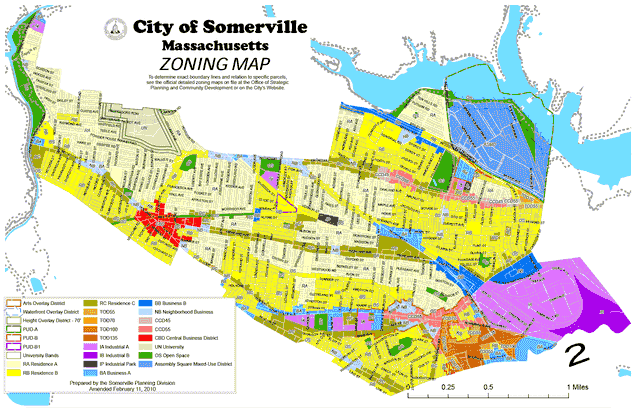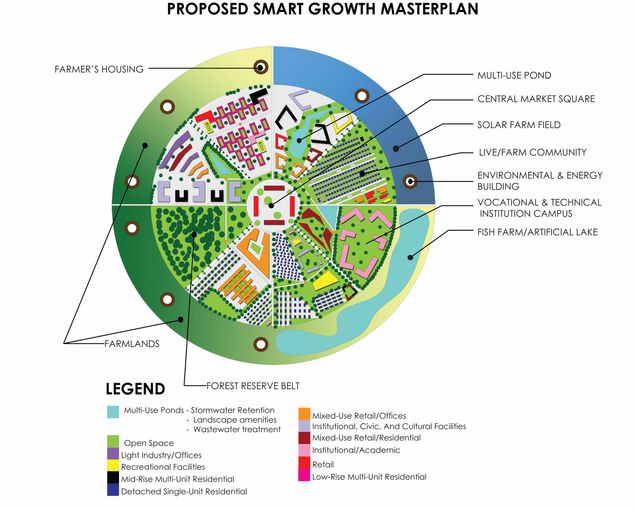The Problems With Euclidean Zoning
Since the1926 landmark Supreme Court case, Village of Euclid v. Ambler Realty Co., 272 U.S. 365, it has been understood that the localities, municipalities, towns, and cities of the United States have the right to zone by dividing the town or community into areas in which specific uses of land are permitted. This is referred to as Euclidean zoning, and is considered the traditional and most common form of zoning in the United States. Euclidean zoning divides towns into districts based on permitted uses, and in so doing creates specific zones where certain land uses are permitted or prohibited. This can be helpful, as it enforces the separation of industrial land uses from residential land uses and can protect against pollution risks. However, Euclidean zoning has also exacerbated segregation issues, limited housing supply, and encouraged urban sprawl. Restrictions on minimum lot sizes, strict building codes, and other elements of Euclidean zoning have increased housing costs, limited new housing construction, worsened affordability issues, and increased the inequality divide in urban areas.
 In Massachusetts, Euclidean zoning is the basis of General Law chapter 40A, the state’s zoning act. Chapter 40A encourages separation of land uses, and gives localities the ability to institute zoning within their borders. Given that Massachusetts has 351 towns, there are a wide variety of zoning bylaws throughout the state, based on each towns’ preferences and personal histories. Over time, Massachusetts’ state government has realized that the Euclidean zoning instituted by towns, aided and abetted by chapter 40A, has created neighborhoods that are dependent on cars and unsustainable. In an era of increased concerns about climate change, global warming, and greenhouse gas emissions, many people struggle to decrease their carbon footprint because they cannot get to the most basic goods and services, like groceries, schools, shopping, and work, without access to a car due to the enforced separation of uses within zoning districts. Separation of uses leads to urban sprawl, which is “the expansion of human populations away from central urban areas into low density monofunctional and usually car-dependent communities.” Increased urban sprawl has created patterns of development with extended infrastructure systems, increased impervious surfaces, and increased adverse impact on natural resources.
In Massachusetts, Euclidean zoning is the basis of General Law chapter 40A, the state’s zoning act. Chapter 40A encourages separation of land uses, and gives localities the ability to institute zoning within their borders. Given that Massachusetts has 351 towns, there are a wide variety of zoning bylaws throughout the state, based on each towns’ preferences and personal histories. Over time, Massachusetts’ state government has realized that the Euclidean zoning instituted by towns, aided and abetted by chapter 40A, has created neighborhoods that are dependent on cars and unsustainable. In an era of increased concerns about climate change, global warming, and greenhouse gas emissions, many people struggle to decrease their carbon footprint because they cannot get to the most basic goods and services, like groceries, schools, shopping, and work, without access to a car due to the enforced separation of uses within zoning districts. Separation of uses leads to urban sprawl, which is “the expansion of human populations away from central urban areas into low density monofunctional and usually car-dependent communities.” Increased urban sprawl has created patterns of development with extended infrastructure systems, increased impervious surfaces, and increased adverse impact on natural resources.
In response to concerns about Euclidean zoning, urban sprawl, and decentralization, Massachusetts’ legislature passed General Law Chapter 40R in hopes of encouraging changes in zoning and development patterns that would combat the impacts of Euclidean zoning. Chapter 40R’s purpose is to encourage smart growth and increased housing production in Massachusetts. Smart growth is a development principle that “emphasizes mixing land uses, increases the availability of affordable housing by creating a range of housing opportunities in neighborhoods, takes advantage of compact design, fosters distinctive and attractive communities, preserves open space, farmland, natural beauty and critical environmental areas, strengthens existing communities, provides a variety of transportation choices, makes development decisions predictable, fair and cost effective and encourages community and stakeholder collaboration in development decisions.”
The issue is that Euclidean zoning, is so ingrained it will be difficult for towns to change their entire structure. Chapter 40R tries to fit smart growth within the existing zoning structure by allowing towns and cities to create smart growth zoning districts in appropriate areas of the town. The state legislature attempts to help towns and cities ease into smart growth concepts by encouraging the development of a comprehensive plan, an affordable housing plan, and a vision plan for their community.
Massachusetts attempts to boost smart growth practices beyond using Chapter 40R. First is to amend the local bylaw. Communities could revise and amend their zoning bylaws to incentivize or require smart growth practices. Within zoning bylaws, communities can allow land uses “by-right” or “as-of-right”, which would permit land uses in a particular district without discretionary review. As such, the use may be regulated but cannot be prohibited. This method is the most predictable and easiest permitting method, so towns may permit land uses they want to encourage, like smart growth, as “by-right” uses. Using the “by-right” approach to make smart growth strategies easier to permit can make smart growth a more attractive option to developers who otherwise would have little incentive to use smart growth techniques when they are costlier and more time consuming to implement.
Another technique to boost smart growth would be to encourage site plan review as a procedure for getting smart growth developments approved. Site plan review is a “coordinated review of a development application between several local agents or boards.” Site plan review can potentially increase the amount and technical nature of the information submitted to the local boards, so communities should use caution in adopting this review technique. Site plan review can be used for “by-right” applications, as well as for special permit applications. “By-right” applications are more complicated, as the use is “by-right” and the reviewing authority does not have the power to deny the use. Once an application is deemed complete, the reviewing authority cannot deny the application, although the reviewing authority “may impose reasonable conditions that further the purposes and standards of the zoning code.” In short, site plan review, “as attached to by-right uses, should be viewed as essentially an administrative review,” and should be viewed as an opportunity for local boards to get more information about a development, not as a way to regulate or deny development.
Special permits were used in Chapter 40A to allow increases in the permissible density of population or intensity of a particular use; authorization of Transfer of Development Rights of land within or between zoning districts; and review of cluster developments, pursuant to the Subdivision Control Law. For smart growth, special permits can be used to enable innovative approaches, allow flexibility, encourage partnerships between developers and the community, provide incentives, and require specific design standards. Special permits are also useful for areas that are previously developed, and can allow redevelopment of preexisting nonconforming uses to encourage infill and active use of developed areas.
Chapter 40R’s main focus is on the use of zoning districts to encourage smart growth. This is done in conformity with Chapter 40A by allowing the creation of new districts or the use of overlay districts. Overlay districts lay on top of existing zoning and can cover many underlying districts or portions of underlying districts. This gives communities the ability to be flexible in regulating uses of land.
Euclidean zoning has been the norm in America for over ninety years, and while it has valuable features, its rigidity can and has exacerbated issues ranging from social issues like segregation, to environmental issues like urban sprawl. Changing this will be difficult, as Euclidean zoning has support for planning purposes as well as for class purposes, but techniques like smart growth, new urbanism, and statewide comprehensive planning can help combat these issues. Massachusetts has made a start at this by enacting Chapter 40R, but still has work to do on the statewide level to incentivize local communities to change their zoning or to make it easier for these zoning changes to occur.
 Rachael Watsky graduated from Boston University School of Law in May 2018.
Rachael Watsky graduated from Boston University School of Law in May 2018.

